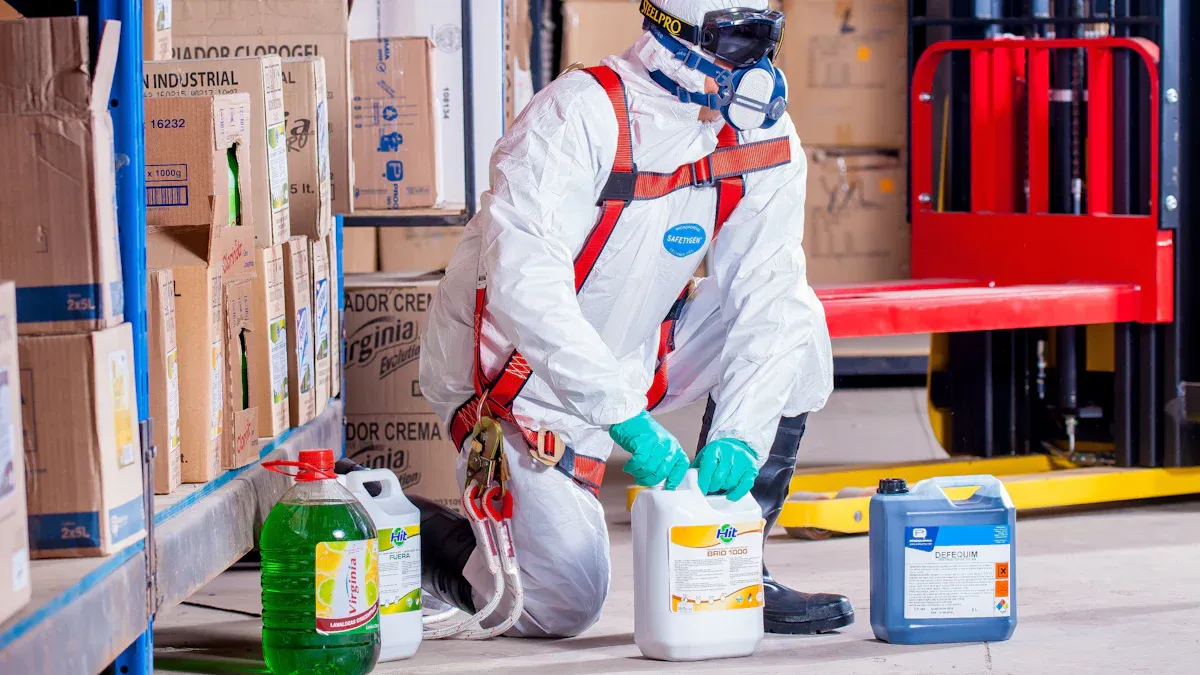
Hazardous environments demand specialized communication tools to ensure safety and reliability. Explosion-proof phones, such as an IP Explosion Proof Telephone, are engineered for areas prone to explosive risks. In contrast, rugged industrial telephones excel in physically demanding settings like construction sites. For example, a 광업 산업 전화 or an analog weatherproof telephone can withstand extreme conditions without compromising performance.
Understanding Explosion-Proof Phones

What Are Explosion-Proof Phones?
Explosion-proof phones are specialized communication devices designed to operate safely in environments with explosive atmospheres. These phones are engineered to prevent sparks or heat that could ignite flammable gases, vapors, or dust. They comply with strict safety standards, such as ATEX and IECEx certifications, ensuring their suitability for hazardous locations. Industries like oil and gas, chemical manufacturing, and mining rely heavily on these devices to maintain safety and operational efficiency.
Key Features of Explosion-Proof Phones
Explosion-proof phones are equipped with advanced features to ensure safety and durability in hazardous environments. Key characteristics include:
- Safe and Secure Mobile Communications: These phones are designed for use in areas classified as Zone 0, Zone 1, and Zone 2, where explosive atmospheres may occur.
- Durability: Built to withstand extreme conditions, these devices ensure long-term reliability.
- Improved Process Visibility: Real-time communication and data sharing enhance operational efficiency.
| Zone | 이름 * |
|---|---|
| Zone 0 | Areas where explosive atmospheres are present continuously or for long periods of time. |
| Zone 1 | Areas where explosive atmospheres may occur during normal operation. |
| Zone 2 | Areas where explosive atmospheres are unlikely to occur during normal operation. |
Benefits and Applications in Hazardous Environments
Explosion-proof phones play a critical role in ensuring safety and efficiency in hazardous settings. For example, in Norwegian oil and gas processing plants, these devices have been shown to enhance work practices and operator interactions. Their user-centered design minimizes ignition risks while complying with safety standards like the Atmosphères Explosives directives. This makes them indispensable in industries such as pharmaceuticals, mining, and chemical manufacturing. By enabling reliable communication and reducing safety risks, explosion-proof phones contribute to smoother operations in high-risk environments.
Tip: While explosion-proof phones are ideal for explosive atmospheres, rugged Industrial Telephones may be better suited for non-explosive but physically demanding environments.
Exploring Rugged Industrial Telephones

What Are Rugged Industrial Telephones?
Rugged industrial telephones are communication devices designed to endure harsh physical conditions. These phones are built with robust materials to resist damage from impacts, extreme temperatures, and moisture. Unlike standard phones, they are tailored for industrial environments where durability and reliability are critical. Industries such as construction, transportation, and manufacturing rely on these devices to maintain seamless communication in challenging settings.
Key Features of Rugged Industrial Telephones
Rugged industrial telephones offer several features that make them suitable for demanding environments. These include:
- Durable Construction: Designed to withstand physical shocks, vibrations, and exposure to dust and water.
- Weather Resistance: Operates effectively in extreme temperatures and adverse weather conditions.
- Enhanced Audio Quality: Equipped with noise-canceling technology to ensure clear communication in noisy environments.
- Long Lifespan: Built to last, reducing the need for frequent replacements.
| 제품 정보 | 이름 * |
|---|---|
| Safe and Secure Communications | Rugged phones provide safe mobile communications in hazardous areas, meeting strict safety standards for explosive environments. |
| Equipment Life | Their durable construction allows operation under extreme conditions, resisting physical shocks, moisture, and heat. |
| Improved Process Visibility | They enable real-time communication and data sharing, enhancing visibility and efficiency in manufacturing processes. |
Benefits and Applications in Industrial Settings
Rugged industrial telephones offer significant advantages in industrial contexts. Their durability ensures uninterrupted communication, even in the most demanding conditions. These devices enhance operational efficiency by enabling real-time data sharing and process monitoring. Their applications span a wide range of industries, including:
- Subways
- High-speed railways
- Highway tunnels
- Petrochemicals
- Metallurgy
- Nuclear energy
- Offshore engineering
- Prisons
- Hospitals
- Bridges
- Mines
By providing reliable communication in these settings, rugged industrial telephones contribute to improved safety and productivity.
Comparing Explosion-Proof and Rugged Industrial Phones
Differences in Protection Levels and Safety Standards
Explosion-proof phones and rugged industrial telephones differ significantly in their protection levels and compliance with safety standards. Explosion-proof devices are designed to prevent or contain explosions in environments with flammable gases, vapors, or dust. These phones meet stringent certifications such as ATEX and IECEx, ensuring their suitability for high-risk zones. Rugged industrial telephones, on the other hand, focus on durability and resistance to physical damage rather than explosion containment. They are built to withstand impacts, extreme temperatures, and moisture, making them ideal for physically demanding environments.
| Feature/Aspect | Intrinsically Safe Phone Cases | Explosion-Proof Enclosures |
|---|---|---|
| Level of Protection | Prevents explosions from occurring | Contains explosions that originate within housing |
| Cost | Generally more affordable | Typically more expensive |
| Usability | Easier to use and carry for personal devices | More suited for protecting larger equipment |
| Common Applications | Oil and gas, chemical manufacturing, mining | Oil and gas, power generation, chemical processing |
This comparison highlights the importance of assessing workplace hazards before choosing a communication device. While explosion-proof phones prioritize safety in explosive atmospheres, rugged industrial telephones excel in environments where physical durability is paramount.
Cost and Budget Considerations
Cost plays a crucial role in selecting the right phone for hazardous environments. Explosion-proof telephones, designed for high-risk zones, typically range from $600 to over $1,500. Their higher price reflects the advanced safety features and compliance with strict regulations. In contrast, rugged industrial telephones for lower-risk environments cost between $300 and $500, as they do not require the same level of certification.
- Explosion-proof telephones for high-risk environments: $600–$1,500
- Rugged industrial telephones for lower-risk environments: $300–$500
- Average price differential: 20–40%, influenced by additional safety features
Government contracts often allocate up to 20% more budget for explosion-proof devices due to comprehensive evaluation processes. Long-term planning and life-cycle cost considerations also play a significant role in public funding mechanisms. Organizations must weigh the upfront costs against the long-term benefits of safety and reliability.
Usability and Functionality in Various Environments
The usability and functionality of explosion-proof and rugged industrial telephones vary depending on the environment. Explosion-proof phones are tailored for industries like oil and gas, chemical processing, and mining, where explosive atmospheres pose significant risks. Their design minimizes ignition hazards while ensuring reliable communication. Rugged industrial telephones, however, are better suited for physically demanding settings such as construction sites, transportation hubs, and manufacturing facilities. These devices offer enhanced durability, weather resistance, and noise-canceling technology, making them ideal for environments with high levels of physical stress and noise.
Both types of phones contribute to operational efficiency, but their applications differ. Explosion-proof phones ensure safety in high-risk zones, while rugged industrial telephones provide durability and reliability in challenging physical conditions. Choosing the right device depends on the specific hazards and requirements of the workplace.
Choosing the Right Phone for Your Hazardous Environment
Identifying Workplace Hazards and Risks
Selecting the right communication device begins with a thorough assessment of workplace hazards. Each environment presents unique risks that influence the type of phone required. For instance, industries like oil and gas or chemical manufacturing often face explosive atmospheres. These settings demand explosion-proof phones to prevent ignition risks. Conversely, construction sites or transportation hubs expose devices to physical stress, making rugged Industrial Telephones a more suitable choice.
Employers should evaluate the frequency and severity of potential hazards. Explosive atmospheres, categorized into zones such as Zone 0, Zone 1, and Zone 2, require devices with specific certifications. In less hazardous environments, durability against impacts, moisture, and extreme temperatures becomes the priority. By identifying these risks, organizations can narrow down their options and ensure the safety of their workforce.
Tip: Conduct regular risk assessments to adapt communication tools to changing workplace conditions.
Evaluating Safety Certifications and Standards
Safety certifications play a critical role in determining the suitability of a phone for hazardous environments. Explosion-proof phones must comply with standards like ATEX and IECEx, which certify their ability to operate safely in explosive atmospheres. These certifications ensure that the devices meet stringent requirements for preventing ignition.
Rugged Industrial Telephones, while not designed for explosive environments, adhere to standards that guarantee durability and reliability. For example, IP ratings indicate resistance to dust and water, while MIL-STD certifications confirm their ability to withstand physical shocks and extreme conditions. Employers should prioritize devices with certifications that align with their specific operational needs.
| Certification/Standard | Purpose |
|---|---|
| ATEX/IECEx | Ensures safety in explosive atmospheres |
| IP Ratings | Indicates resistance to dust and water |
| MIL-STD | Confirms durability under physical and environmental stress |
Understanding these certifications helps organizations make informed decisions, ensuring compliance with safety regulations and enhancing workplace security.
Balancing Cost, Durability, and Features
Balancing cost, durability, and features is essential when choosing between explosion-proof and rugged industrial phones. Explosion-proof smartphones, equipped with advanced features, are gaining popularity due to their suitability for industrial applications. However, their higher cost, ranging from $600 to $1,500, reflects the complexity of their design and certifications. Industries with budget constraints may opt for feature phones, which offer cost-effectiveness and durability.
Rugged Industrial Telephones, priced between $300 and $500, provide a more affordable option for environments that do not require explosion-proof capabilities. Recent advancements, such as liquid metal technology, have enhanced the durability of explosion-proof phones, making them a long-term investment for hazardous settings. Organizations must weigh the upfront costs against the benefits of safety, reliability, and operational efficiency.
- Explosion-proof phones: Ideal for high-risk zones; higher cost due to advanced safety features.
- Rugged industrial phones: Suitable for physically demanding environments; cost-effective and durable.
- Emerging technologies: Innovations like liquid metal technology improve durability and expand application possibilities.
By carefully evaluating these factors, businesses can select a device that meets their safety requirements without exceeding their budget.
Explosion-proof phones and rugged industrial phones serve distinct purposes. Explosion-proof devices ensure safety in explosive atmospheres, while rugged phones excel in physically demanding environments.
Key Insight: Effective communication prevents accidents and improves emergency response. For instance, an oil rig worker can quickly alert their team about a gas leak using an intrinsically safe phone, avoiding disasters.
Assessing workplace hazards is essential. Use explosion-proof phones for explosive risks and rugged phones for durability in tough conditions.
제품 정보
What is the difference between ATEX and IECEx certifications?
ATEX applies to European Union standards, while IECEx is an international certification system. Both ensure explosion-proof devices meet safety requirements for hazardous environments.
Can rugged industrial phones be used in explosive atmospheres?
No, rugged industrial phones lack the certifications required for explosive atmospheres. They are designed for durability in physically demanding but non-explosive environments.
Tip: Always verify the safety certifications of a device before using it in hazardous areas.
Are explosion-proof phones compatible with modern communication systems?
Yes, many explosion-proof phones support modern systems like VoIP and LTE. They combine advanced technology with safety features for seamless communication in hazardous zones.
💡 Note: Check device specifications to ensure compatibility with your existing infrastructure.


